South Korea Blood Glucose Monitoring Market Size
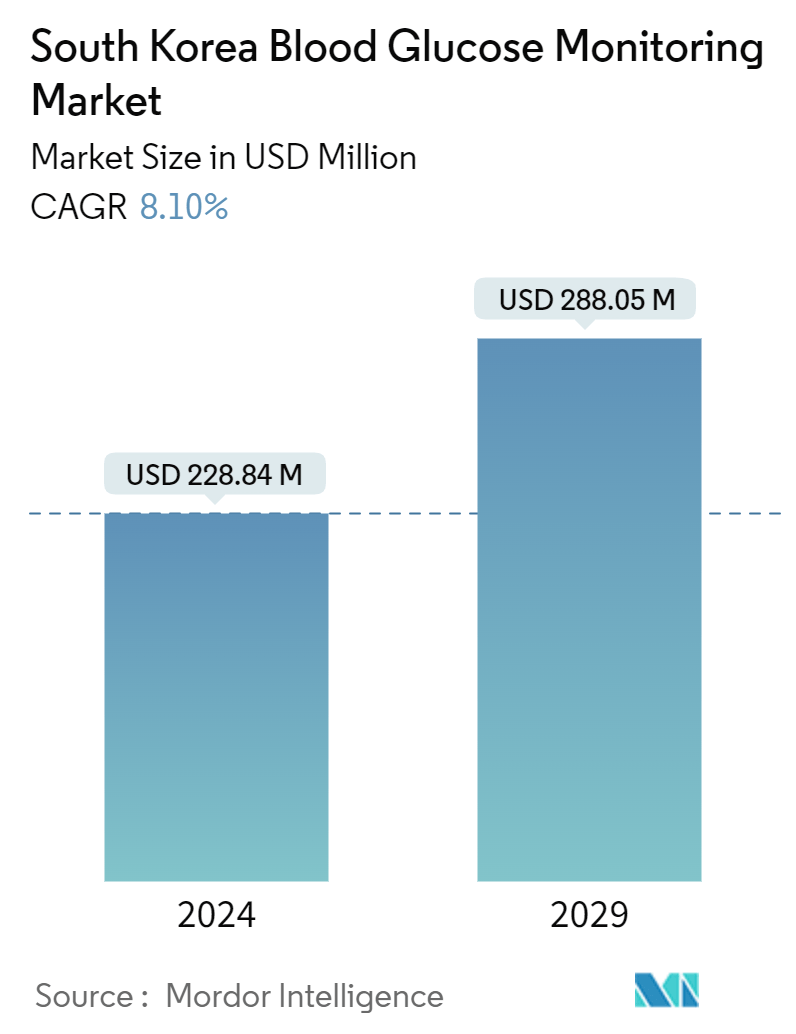
| Study Period | 2019 - 2029 |
| Base Year For Estimation | 2023 |
| Forecast Data Period | 2024 - 2029 |
| Market Size (2024) | USD 228.84 Million |
| Market Size (2029) | USD 288.05 Million |
| CAGR (2024 - 2029) | 8.10 % |
Major Players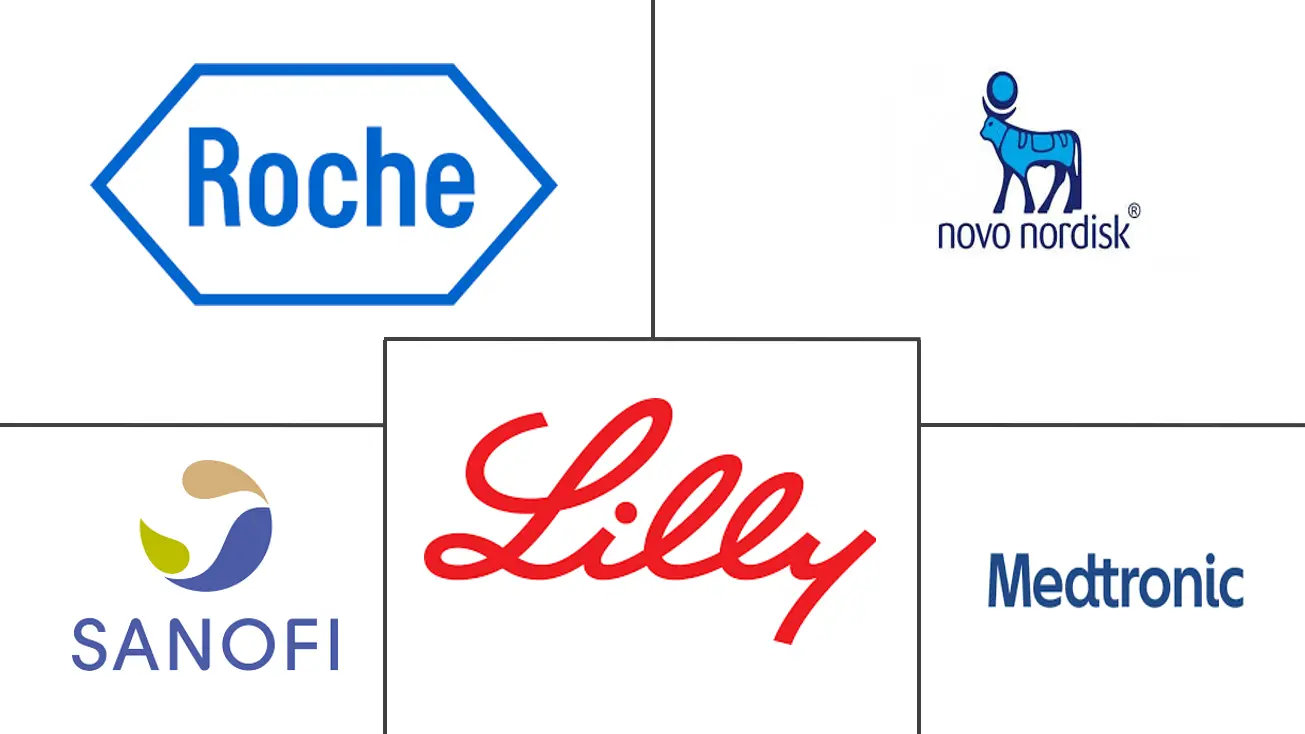
*Disclaimer: Major Players sorted in no particular order |
South Korea Blood Glucose Monitoring Market Analysis
The South Korea Blood Glucose Monitoring Market size is estimated at USD 228.84 million in 2024, and is expected to reach USD 288.05 million by 2029, growing at a CAGR of 8.10% during the forecast period (2024-2029).
The blood glucose device market in South Korea has experienced significant growth in recent years, largely driven by the increasing population of individuals with diabetes. Similar to other developed countries, South Korea has witnessed a rise in diabetes prevalence due to factors such as an aging population, urbanization, and changes in lifestyle habits including dietary patterns and reduced physical activity.
With the rising number of diabetes diagnoses in South Korea, there is a growing demand for blood glucose monitoring devices to aid patients in effectively managing their condition. These devices play a crucial role in diabetes management by allowing individuals to regularly monitor their blood sugar levels and make informed decisions regarding their diet, exercise, and medication adjustments.
The South Korean blood glucose device market offers a wide range of products, including traditional blood glucose meters, continuous glucose monitoring (CGM) systems, and flash glucose monitoring systems. Traditional blood glucose meters remain popular among many patients due to their affordability and ease of use. However, there has been an increasing interest in CGM systems, which provide continuous, real-time glucose monitoring without the need for frequent fingerstick tests.
The growing adoption of blood glucose monitoring devices in South Korea signifies a shift towards personalized and proactive approaches to diabetes management. These devices not only assist individuals with diabetes in maintaining better control of their blood sugar levels but also empower them to make lifestyle changes that can reduce the risk of diabetes-related complications in the long run.
Therefore, owing to the aforementioned factors the studied market is anticipated to witness growth over the analysis period.
South Korea Blood Glucose Monitoring Market Trends
Increasing Type-1 diabetes population across South Korea
Diabetes is a metabolic disorder marked by hyperglycemia and impaired insulin function. Diabetes is becoming more common all over the world, including in Korea. Furthermore, the age of onset of diabetes is shifting toward a younger population, particularly in Asian countries. In the twenty-first century, the prevalence of type 2 diabetes in adolescence rapidly increases, posing major clinical challenges and public health burdens worldwide.
Type 1 diabetes was previously thought to be the most common type of diabetes in young people. However, the prevalence of type 2 diabetes is rising among Asians. The increasing prevalence of diabetes is a health problem that most countries are concerned about. The prevalence varies by race, but overall, it has increased compared to the past.
Diabetes mellitus is widespread and imposes a significant socioeconomic burden on individuals and society through high medical costs. The total economic burden of diabetes in South Korea has been estimated to be USD 18,293 million, or approximately 1.14% of Korea's GDP (GDP). Medical costs accounted for the greatest proportion of total costs, accounting for 42.7% of total economic costs for inpatient services.
In South Korea, the prevalence of diabetes in adults is higher and the economic burden of diabetes is higher than that of overall cancer. Diabetic complications or related comorbidities and hospitalization are associated with high costs for diabetes as a cost driver. Effective strategies are needed to manage patients with diabetic complications to reduce the use of healthcare resources and economic burden. It is expected that increased information regarding both the magnitude and the specific components of the economic burden of diabetes in Korea will influence health policymakers to prioritize its prevention and management and to allocate more healthcare resources to diabetes.
As a result of the factors above, the growth of the studied market in Russia is anticipated.
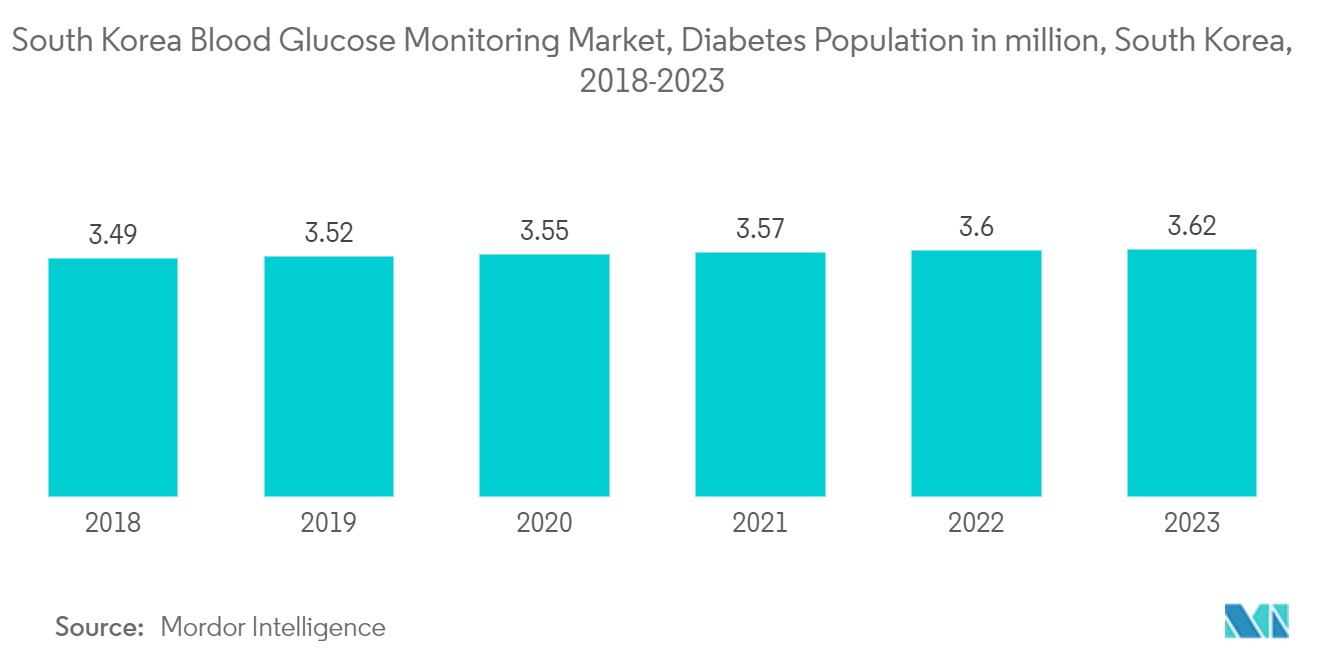
Continuous Glucose Monitoring Holds Highest CAGR in South Korea Blood Glucose Monitoring Market.
Diabetes is a complex and chronic disease that can cause blindness, neuropathy, kidney disease, myocardial infarction, or stroke. It is critical for patients to control their glucose levels on a daily basis to avoid aggravation and the onset of complications. Apps for real-time continuous glucose monitoring (CGM) on smartphones and other devices linked to CGM systems have recently been developed, and such CGM apps are being used in Japan as well. When compared to traditional retrospective CGM, using CGM apps improves patients' own blood glucose control, which is expected to help slow the progression of type 2 diabetes mellitus (DM) and prevent complications.
Diabetes is a significant health problem and one of the astounding challenges for healthcare systems all over South Korea. The prevalence of known type 1 & 2 diabetes in the South Korean adult population is very high along with a high number of patients who are not yet diagnosed with the disease. Due to an aging population and unhealthy lifestyle (the percentage of energy intake from carbohydrates is higher in diabetes patients than in those without diabetes, while that from protein and fat is lower in subjects with diabetes), the prevalence of type 2 diabetes is expected to increase steadily over the next few years.
High-quality care, including adequate monitoring, control of risk factors, and active self-management are the key factors for preventing complications in South Korean patients with type 2 diabetes. The Ministry of Food and Drug Safety (MFDS), South Korea's medical device market regulator, plans to roll out several amendments to the country's Medical Devices Act and has also expanded its list of devices eligible for electronic indications for use. Penetration of remote patient monitoring devices in the South Korean market supports local clinical research organizations (CROs) in their clinical research trials and ensures ease of monitoring, which facilitates the discovery process.
The increased diabetic prevalence in Russia and the aforementioned factors are likely to drive segment growth during the forecast period.
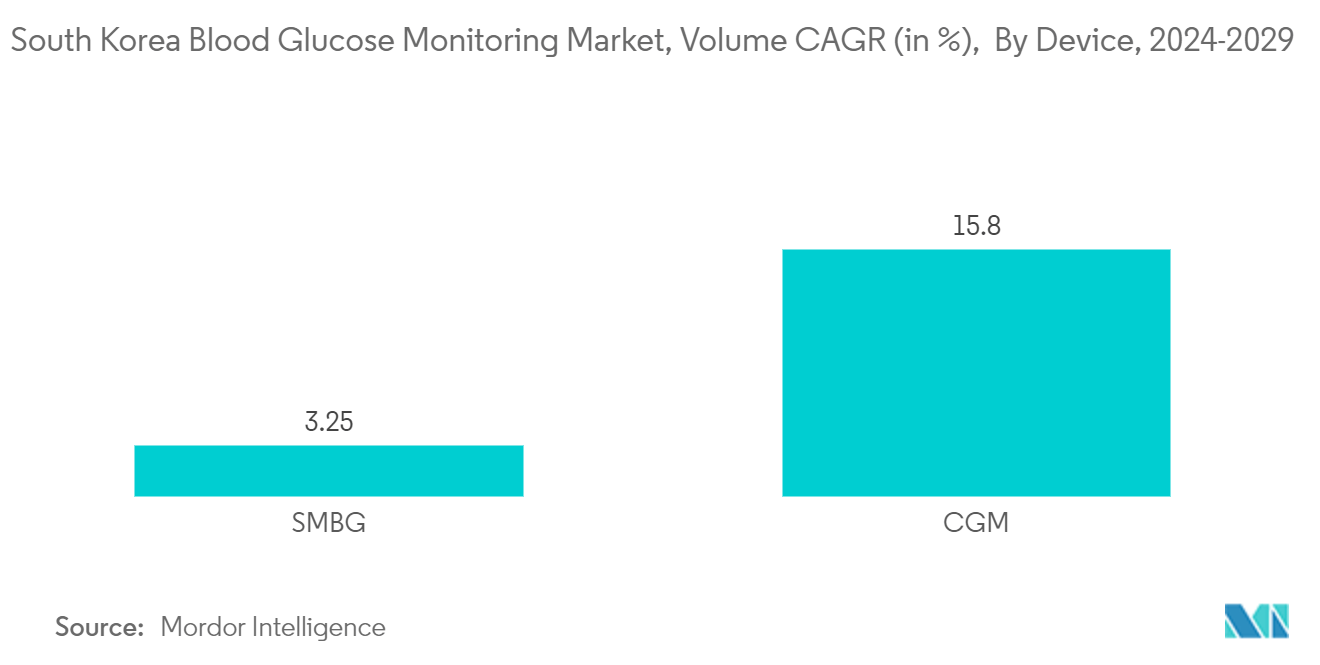
South Korea Blood Glucose Monitoring Industry Overview
The blood glucose monitoring market is highly fragmented, with few major manufacturers present in the market. The CGM devices market is dominated by major players like Dexcom, Medtronics, Abbott, and Senseonics. The market for BGM devices comprises more generic players like Roche, LifeScan, Arkray, Ascensia, etc. Technological innovations in the recent past helped companies to strengthen their market presence.
South Korea Blood Glucose Monitoring Market Leaders
-
Roche
-
Abbott
-
Medtronics
-
Dexcom
-
LifeScan
*Disclaimer: Major Players sorted in no particular order
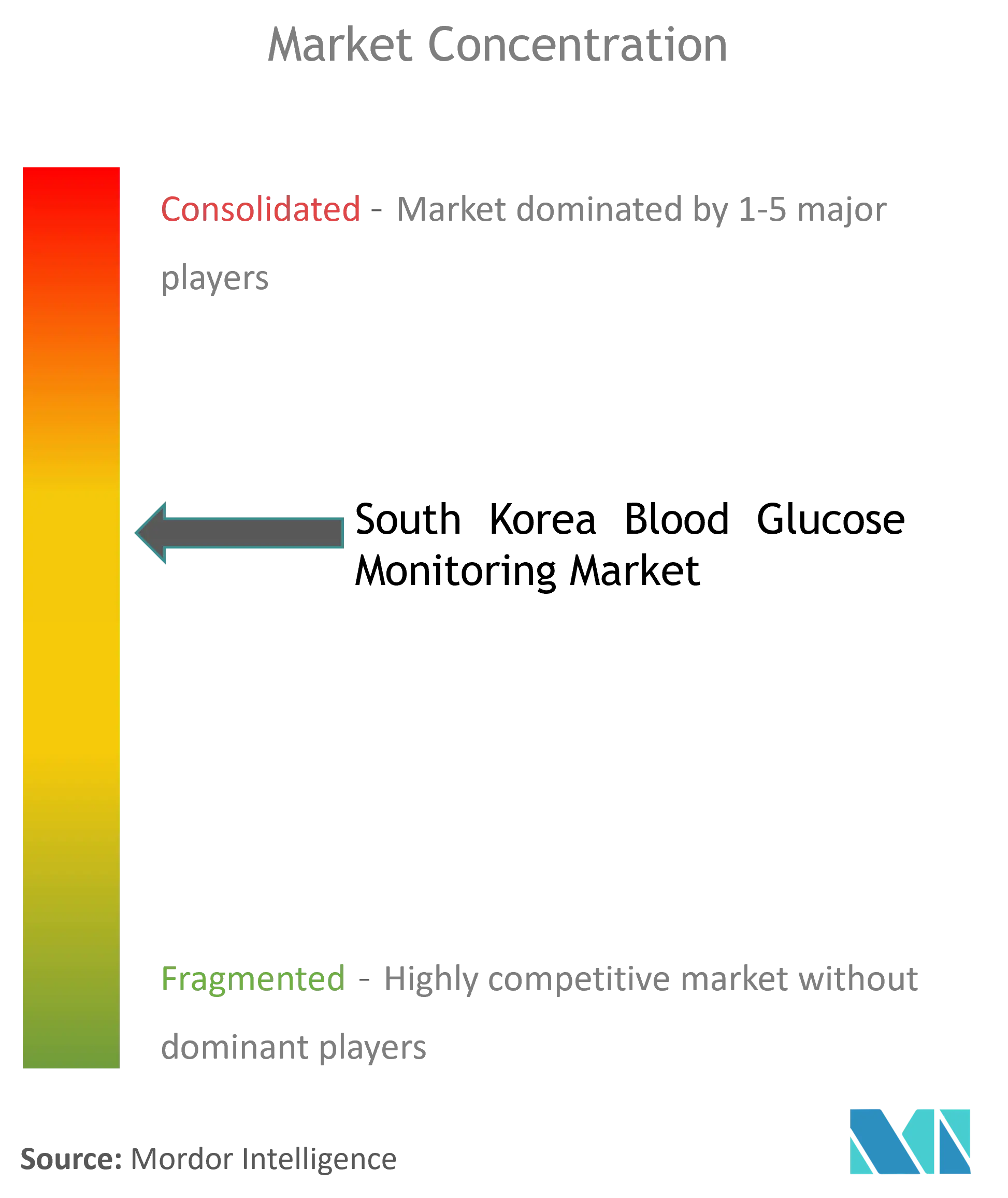
South Korea Blood Glucose Monitoring Market News
- July 2023: i-SENS, a CGM manufacturer based in South Korea, announced that it has obtained regulatory clearance for CareSens Air, the initial CGM device developed domestically. In March, i-SENS submitted the required documentation to the government for approval. The Ministry of Food and Drug Safety did not require additional supporting paperwork, resulting in an earlier approval than expected.
- August 2021: FIND announced that agreements had been signed with i-SENS, Inc. (Seoul, South Korea) and SD BIOSENSOR, Inc. (Suwon-si, South Korea) to increase low- and middle-income countries (LMIC) access to blood glucose test strips by improving affordability.
South Korea Blood Glucose Monitoring Market Report - Table of Contents
1. INTRODUCTION
- 1.1 Study Assumptions and Market Definition
- 1.2 Scope of the Study
2. RESEARCH METHODOLOGY
3. EXECUTIVE SUMMARY
4. MARKET DYNAMICS
- 4.1 Market Overview
- 4.2 Drivers
- 4.3 Restraints
-
4.4 Porter's Five Forces Analysis
- 4.4.1 Bargaining Power of Suppliers
- 4.4.2 Bargaining Power of Consumers
- 4.4.3 Threat of New Entrants
- 4.4.4 Threat of Substitute Products and Services
- 4.4.5 Intensity of Competitive Rivalry
5. MARKET SEGMENTATION
-
5.1 Self-monitoring blood glucose devices
- 5.1.1 Glucometer Devices
- 5.1.2 Test Strips
- 5.1.3 Lancets
-
5.2 Continuous blood glucose monitoring devices
- 5.2.1 Sensors
- 5.2.2 Durables (Receivers and Transmitters)
6. MARKET INDICATORS
- 6.1 Type-1 Diabetes population
- 6.2 Type-2 Diabetes population
7. COMPETITIVE LANDSCAPE
-
7.1 COMPANY PROFILES
- 7.1.1 Abbott Diabetes Care
- 7.1.2 Roche Holding AG
- 7.1.3 LifeScan
- 7.1.4 Dexcom Inc.
- 7.1.5 Medtronic PLC
- 7.1.6 Arkray Inc.
- 7.1.7 Ascensia Diabetes Care
- 7.1.8 Agamatrix Inc.
- 7.1.9 Bionime Corporation
- 7.1.10 Acon Laboratories Inc.
- 7.1.11 Trivida Functional Medicine
- 7.1.12 Senseonics
- *List Not Exhaustive
-
7.2 COMPANY SHARE ANALYSIS
- 7.2.1 Self-monitoring Blood Glucose Devices
- 7.2.1.1 Abbott Diabetes Care
- 7.2.1.2 Roche Holding AG
- 7.2.1.3 LifeScan
- 7.2.2 Continuous Glucose Monitoring Devices
- 7.2.2.1 Dexcom Inc.
- 7.2.2.2 Medtronic PLC
- 7.2.2.3 Abbott Diabetes Care
8. MARKET OPPORTUNITIES AND FUTURE TRENDS
** Subject To AvailablitySouth Korea Blood Glucose Monitoring Industry Segmentation
Continuous glucose monitoring (CGM) systems, another type of blood glucose monitoring device, provide real-time glucose readings throughout the day via a sensor inserted under the skin, transmitting data wirelessly to a receiver or smartphone app. These devices play a crucial role in helping individuals with diabetes make informed decisions about their diet, medication, and lifestyle to maintain optimal blood sugar control and prevent complications associated with the disease. South Korea Blood Glucose Monitoring Market is segmented into type and component. The report offers the value (in USD) and volume (in Units) for the above segments.
| Self-monitoring blood glucose devices | Glucometer Devices |
| Test Strips | |
| Lancets | |
| Continuous blood glucose monitoring devices | Sensors |
| Durables (Receivers and Transmitters) |
South Korea Blood Glucose Monitoring Market Research FAQs
How big is the South Korea Blood Glucose Monitoring Market?
The South Korea Blood Glucose Monitoring Market size is expected to reach USD 228.84 million in 2024 and grow at a CAGR of 8.10% to reach USD 288.05 million by 2029.
What is the current South Korea Blood Glucose Monitoring Market size?
In 2024, the South Korea Blood Glucose Monitoring Market size is expected to reach USD 228.84 million.
Who are the key players in South Korea Blood Glucose Monitoring Market?
Roche, Abbott, Medtronics, Dexcom and LifeScan are the major companies operating in the South Korea Blood Glucose Monitoring Market.
What years does this South Korea Blood Glucose Monitoring Market cover, and what was the market size in 2023?
In 2023, the South Korea Blood Glucose Monitoring Market size was estimated at USD 210.30 million. The report covers the South Korea Blood Glucose Monitoring Market historical market size for years: 2019, 2020, 2021, 2022 and 2023. The report also forecasts the South Korea Blood Glucose Monitoring Market size for years: 2024, 2025, 2026, 2027, 2028 and 2029.
South Korea Blood Glucose Monitoring Industry Report
Statistics for the 2024 South Korea Blood Glucose Monitoring market share, size and revenue growth rate, created by Mordor Intelligence™ Industry Reports. South Korea Blood Glucose Monitoring analysis includes a market forecast outlook 2029 and historical overview. Get a sample of this industry analysis as a free report PDF download.



